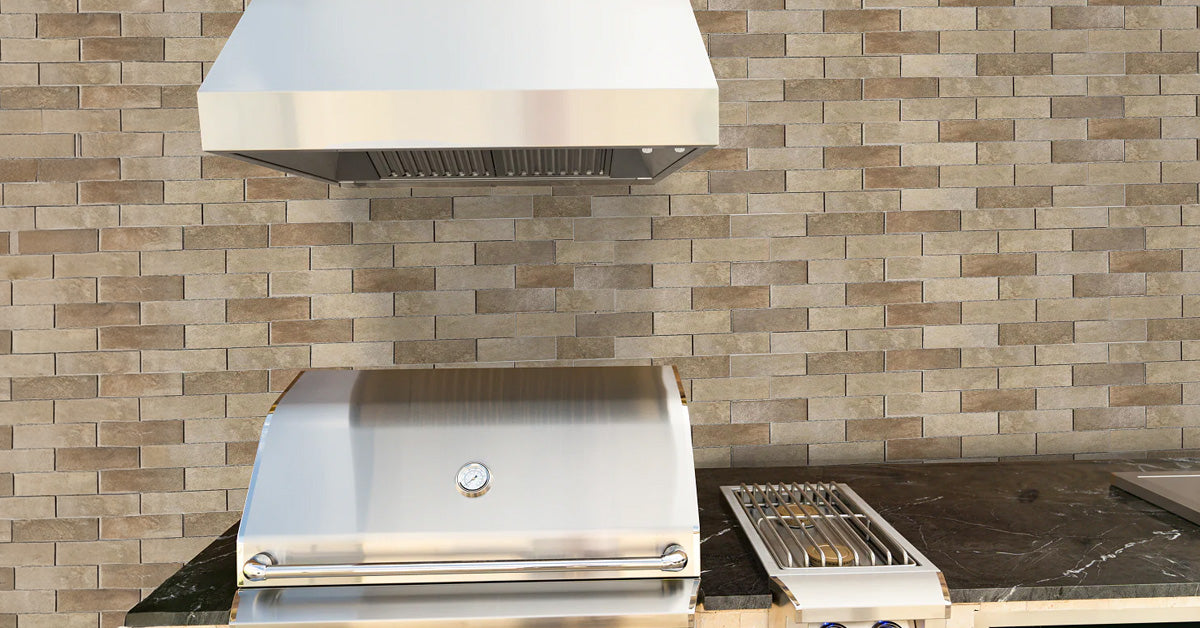How do you know if you need to include a vent hood in your outdoor kitchen? It’s simple: If your outdoor kitchen will be installed under a covered pavilion, lanai, porch, pool house, or other structure with a solid ceiling, you need a ventilation hood above the grill. If your grill or outdoor kitchen is completely in the open air and uncovered by a structure, you do not.
Since more than half of all outdoor kitchen projects today now include some type of overhead structure, according to the National Kitchen & Bath Association (NKBA), there’s a good chance a vent hood should be in your design plans. A solid roof provides shade and shelter from the elements, so you can get more use and enjoyment out of your outdoor living area. A vent hood enhances the experience and helps protect your investment.
Beyond that, there are safety reasons for incorporating a vent hood. In fact, your area’s municipal construction and fire codes may require one over any grill installed beneath a combustible overhead structure.
What Does a Vent Hood Do?
Just as it functions in an indoor kitchen, a vent hood incorporates a powerful fan to draw smoke, heat, grease, and food odors away from the grill and out of the outdoor living space. It keeps cooking smoke from bothering guests, and prevents grimy residue from collecting on the ceiling, walls and soft surfaces, discoloring paint and damaging outdoor furnishings.
How to Choose a Vent Hood?
To determine the proper size, keep in mind the hood should extend about six inches beyond the dimensions of the grill. For example, if you have a 30-inch grill, you’ll need a 36-inch vent hood; if you have a 42-inch grill, you need a 48-inch vent hood.
If you have multiple grills, you will need a hood over each outdoor cooking appliance. An alternate option, albeit a more costly one, would be to have a custom hood made large enough to cover the two (or more) grills side by side.
Feature List
Look for a fan blower with a high CFM rating, an indicator of how much air it moves. The fan should be powerful enough to do the job in an outdoor environment, even in breezy conditions.
A multispeed fan allows you to select the fan speed that best suits whatever you’re grilling – a low setting might be fine for a quick-cooking, boneless chicken breast, but you’ll want to crank it up for bacon or smoky cedar-planked salmon. A quiet motor is key; it won’t drown out the conversation or the game on the outdoor tv. And, built-in lights are handy, too, so you can see what you’re grilling.
Choose a hood made from durable, high-quality stainless-steel materials that will hold up amid the grease, smoke and frequent cleanings. Yup, you heard that right: frequent cleanings. A vent hood should be cleaned twice a month or after every 24 hours of use to prevent staining and grime build up. To make the task easier (read: one you’ll be more likely to do), look for filters that are easy to remove and dishwasher safe. The hood itself should be cleaned inside and out with a non-abrasive cloth and soapy water.
Installation
A vent hood is an electric appliance, so installation requires a licensed electrician.
The optimal positioning is between 30 and 36 inches above the cooking surface. This provides enough clearance to open the grill lid, but ensures the fan is not so high that breezes will prevent it from drawing properly.
Most vent hoods are made of stainless steel to coordinate seamlessly with grills and outdoor appliances. But you may use a hood as a liner inside a customized, decorative surround if you’re looking to create a focal point in your outdoor kitchen or match the hood to your outdoor cabinetry.
Vent hoods like these from Renaissance Cooking Systems (RCS), check all the boxes and won’t break the bank. Available in 36- and 48-inch sizes, they’re crafted from premium 304 stainless steel, feature powerful, dual fan blowers totaling 1,200 CFMs, and have adjustable fan speeds, dual interior lights and dishwasher-safe filters. They’re a smart investment if you’re investing in a covered outdoor kitchen.
For more information, visit www.rcsgasgrills.com or click here.


